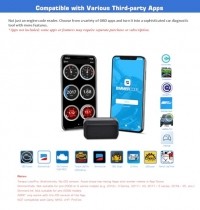Have you upgraded your tires and noticed your speedometer is no longer accurate? It’s a common issue after modifications, and thankfully, there’s a cheap and effective DIY solution using an OBD2 module and a smartphone app. This guide will walk you through how to use an “Obd2 Mileage Correction App” to get your speedometer reading accurately again.
For those looking for an affordable and functional fix, a Bluetooth OBD2 module paired with the right app is the answer. I recently tested the Veepeak OBDCheck BLE Bluetooth OBD II Scanner, available on Amazon, and found it to be an excellent and budget-friendly option.
This module, which cost me around $25, is compatible with both iOS and Android devices. To unlock its mileage correction capabilities, you’ll need a compatible app. After researching various options and considering user reviews and features, I chose OBD Fusion, which is available for about $10.
 Veepeak OBDCheck BLE Bluetooth OBD II Scanner plugged into a car's OBD2 port
Veepeak OBDCheck BLE Bluetooth OBD II Scanner plugged into a car's OBD2 port
The combination of the Veepeak module and OBD Fusion app worked perfectly on my Gen 3 Toyota Tundra. OBD Fusion provides real-time data monitoring, including parameters like boost pressure, and crucially, it allows for speedometer adjustment to compensate for tire size changes.
To correct your speedometer, navigate to the settings menu within OBD Fusion, then to “vehicle editor,” and scroll down to the “vehicle speed scale factor” table. If you’ve installed larger tires, like my 285/75R18 (35-inch tires), you’ll need to adjust this scale factor. I set mine to 1.16, and it now aligns perfectly with my GPS speed readings.
The app adjusts the speed based on percentages, ensuring accuracy across all speeds. You might need to experiment slightly to find the ideal setting for your specific tire size, but starting around 1.15 is a good baseline for 35-inch tires. Keep in mind that this correction is displayed within the app and does not alter the vehicle’s physical speedometer gauge. For me, this is a minor trade-off, especially as it ensures my mileage is recorded more accurately.
Beyond mileage correction, OBD Fusion is highly customizable. I use my smartphone as a digital gauge cluster, displaying corrected speed, boost, coolant and oil temperatures, battery voltage, and torque output. It’s a fantastic way to monitor vehicle performance.
While there are other options available, like the Banks iDash gauge, which offers integration with other Banks products, the cost (over $300) didn’t justify the benefits for my needs, especially without current ECU tuning options for my Toyota.
For a fraction of the cost, the OBD2 module and app solution delivers significant value. For around $35 total, you gain accurate speed readings, mileage correction, real-time vehicle monitoring, and diagnostic capabilities. Plus, the module is portable and can be used across different vehicles for code checking and more. This setup is not only perfect for daily driving but also invaluable for off-road adventures. If you’re looking for an “obd2 mileage correction app”, this combination is a great place to start.